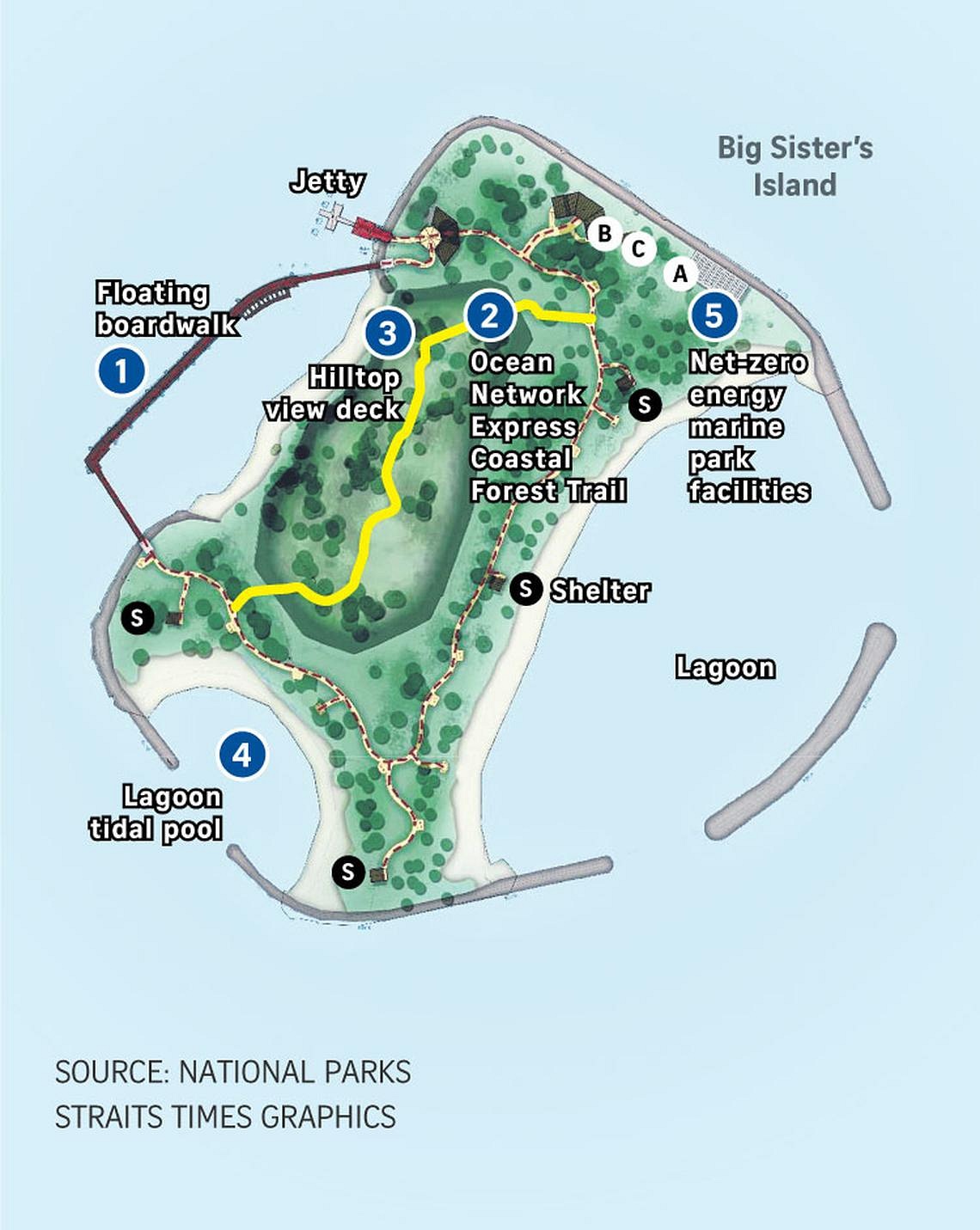
More details from media articles.
Revamped Big Sister's Island reopens after 3 years, with floating boardwalk and tidal pools
Visitors to the island can view various species of fish and coral, and even swim or snorkel in the tidal pool.
Charmaine Jacob Channel NewsAsia 28 Oct 2024.
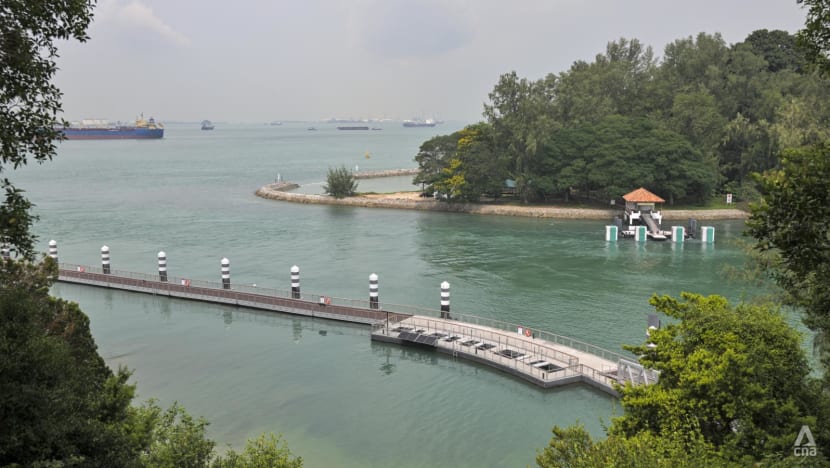
SINGAPORE: Big Sister’s Island reopened to the public on Monday (Oct 28) after three years of enhancement works.
The revamped island has several new features such as a floating boardwalk, a coastal forest trail and a lagoon tidal pool where visitors can swim or snorkel.
The island’s new features give visitors more opportunities to get close to Singapore’s rich array of marine and terrestrial biodiversity such as coral reefs and mangroves, the National Parks Board (NParks) said.
Sisters’ Islands Marine Park, the country's first marine park, plays an important role in conservation, research, outreach and education.
The blacktip reef shark, copperband butterflyfish and giant carpet anemone are some of the aquatic creatures that can be found in waters surrounding the marine park.
Although the park spans across 40 hectares, only Big Sister’s Island is accessible to the public. Small Sisters’ Island, which is earmarked for marine conservation, continues to be off-limits.
Singapore announced in May that the southern islands - Kusu and Lazarus - have been picked as the proposed site for the country's second marine park. The reefs of Lazarus Island and Kusu Island are home to 97 and 141 coral species respectively, including certain rare ones, said NParks.
Opening the park on Monday, Minister for National Development Desmond Lee said Singapore's rich array of marine biodiversity is constantly being threatened by climate change and environmental pollution.
"Singapore’s waterways are one of the busiest in the world, serving one of the busiest ports internationally. There are many demands on our waters. For example, commerce, shipping, industry, food and aquaculture, as well as recreation, to name a few," Mr Lee said.
He also briefly spoke about an oil spill from a pipeline belonging to major energy company Shell that occurred on Oct 20, saying that no oil was observed at Sisters’ Islands Marine Park.
"Events such as oil spills and coral bleaching are a sobering reminder of just how vulnerable our marine ecosystems are".
Visitors to Sisters’ Islands Marine Park can catch a ferry from Marina South Pier. Singapore Island Cruise and Ferry Services will commence ferry services to the marine park from Tuesday.
These are the new features visitors can look out for.
FLOATING BOARDWALK

Visitors to Big Sister’s Island will spot Singapore’s first floating boardwalk once they disembark from the ferry.
Spanning across 220m, the boardwalk doubles as a coral habitat and research site.
Regardless of tide level, members of the public will be able to view corals and different species of fish swimming in and around the coral panels.
There are 63 coral panels on the lower sides of the boardwalk that will provide a suitable substrate for corals to grow.
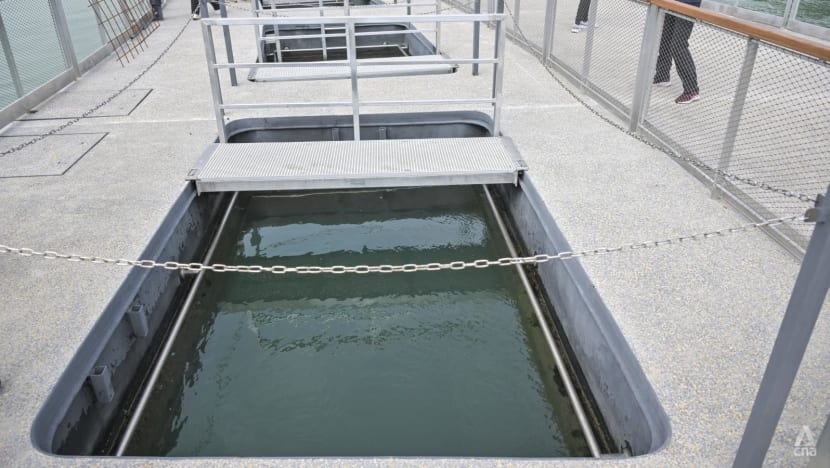
NParks said that it is currently working to install a camera there to observe the corals during daytime. The camera will be deployed into the water during day time, but will be brought up at night for cleaning and maintenance.
There are also five square pools of water - known as moon pools - along the boardwalk that will allow for various marine experiments to be carried out. This will help researchers study both the naturally established and transplanted corals in a field setting.
LAGOON TIDAL POOL
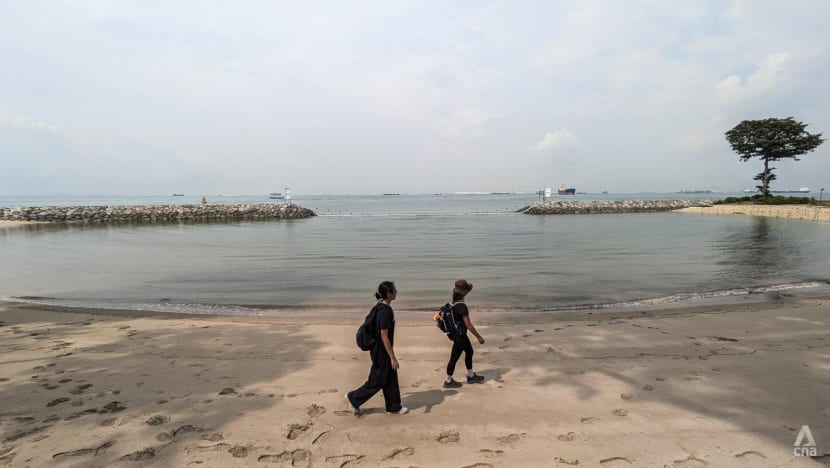
The smaller of two existing lagoons at Big Sister’s Island has been restructured into a tidal pool that will retain seawater during low tides, creating a sheltered water body that will boost growth of mangrove propagules and seagrass inside the lagoon.
Visitors will hence be able to partake in intertidal walks to get up close to marine plants and animals such as the Haddon's Carpet Anemone, Sandfish and Flowercrab, and even swim and snorkel during low tide. Lucky ones might even spot otters and turtles in the water.
Over time, the tidal pool will grow into a multi-habitat ecosystem that can support a wide range of marine biodiversity, such as the Spoon seagrass, Api-api Jambu and the Common sea star.
The development of the tidal pool and its programmes are supported by a S$1 million (US$760,000) donation from Singtel through the Garden City Fund.
Part of that donation also involves Singtel’s IT services arm designing an underwater video system to increase marine research and community engagement programmes. This will enable the tidal pool to double up as a “marine classroom,” the telecommunications company said.
COASTAL FOREST TRAIL
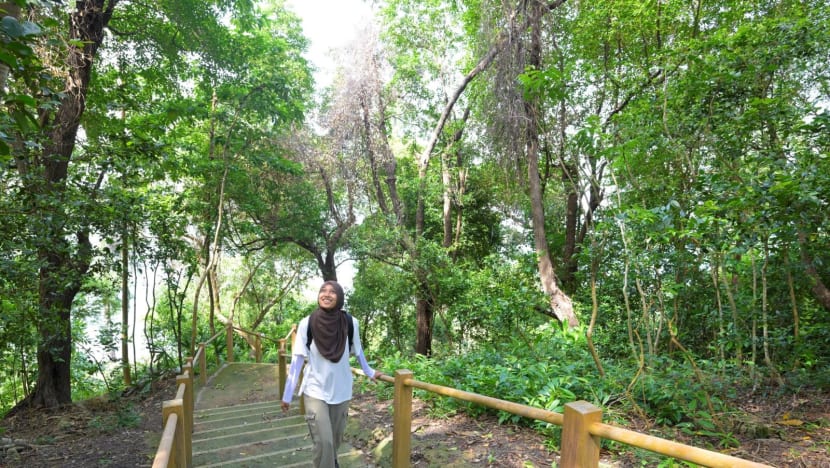
Visitors who want a bird’s eye view of Big Sister’s Island can trek up the new Ocean Network Express Coastal Forest Trail.
They will be able to see critically endangered coastal species around the trail, such as the Putat Laut and Penaga Laut plants.
The 230m long trail will bring visitors through a coastal forest that will lead to a two-storey high hilltop view deck - the highest point of the island.
This will be a prime spot for birdwatchers who can keep an eye out for the critically endangered great-billed heron, spotted wood owl, and white-bellied sea eagle.
The coastal trail is supported by a S$1 million donation from Ocean Network Express through NParks’ Garden City Fund.
NET-ZERO ENERGY ISLAND
Sisters’ Islands is now a net-zero energy marine park that is fully powered by solar energy.
Located at the northern side of Big Sister’s Island, a solar farm with 88 solar panels will provide all the island’s electricity needs and power the desalination plant.
Placed at the brightest area of the island, this will meet the marine park’s estimated annual electricity consumption of 19,000 kWh. This is equivalent to the yearly electricity consumption of a four-room HDB flat.
The new solar-powered desalination plant will convert seawater into clean water, providing the marine park with clean water. There is also a water tower that can store 8,000 litres of clean water, so no power source is required to distribute water.
Solar tubes will be used in the toilets instead of artificial lighting. Although there are open showers outside the toilet, there are currently no water coolers on the island.
OTHER CONSERVATION FEATURES
Home to a large variety of biodiversity, different types of reef enhancement units have also been placed on Sisters’ Islands Marine Park to give corals and other marine life habitat.
NParks is also testing out the use of mineral accretion technology to enhance growth of hard corals by subjecting them to low-voltage electricity - a first in Singapore. Around 250 species of hard corals have been documented in Singapore’s waters out of over 800 species found worldwide.
Apart from aquatic creatures, NParks has also built kingfisher burrows, bee hotels, bat boxes and wildlife piles around Big Sister’s Island, providing more nesting sites to the wildlife.
Benches around the marine park are also made from recycled casuarina timber from the island, while rope barriers have been made from decommissioned hoses from the Singapore Civil Defence Force.
NParks will also look into using recycled hoses for hammocks and bench tops around the marine park.
Mr Lee also announced on Monday that NParks and the National University of Singapore have launched the second phase of the Comprehensive Marine Biodiversity Survey.
The survey aims to build on the information collected from the first phase in 2010 and provide a more complete picture of Singapore’s marine biodiversity. This will help NParks plan and strategise how to better conserve natural capital and enhance Singapore's climate and ecological resilience.
"Our efforts to meaningfully conserve and steward our marine biodiversity depend on having a good understanding of the environment, and of course, good data", Mr Lee said.
Sisters’ Islands Marine Park reopens; visitors can hike a coastal trail and see corals up close
Shabana Begum and Chin Hui Shan Straits Times 28 Oct 2024.
SINGAPORE – After three years of rejuvenation works, the biodiversity-rich Sisters’ Islands Marine Park reopened to the public on Oct 28, beckoning visitors with lagoons to swim in, corals to see up close, and a coastal forest trail that offers panoramic views of Singapore’s southern islands.
The jewel of the 40ha Sisters’ Islands Marine Park, Big Sister’s Island, is the only place in the marine park that is open to visitors. Small Sister’s Island is zoned for research and conservation, while the western reefs of both St John’s Island and Pulau Tekukor are submerged.
In 2021, Big Sister’s Island underwent upgrading works to make it more visitor-friendly and to serve as a place for people to learn more about Singapore’s marine life, which is often invisible to the city dweller.
Now, the spruced-up island, located about a 30-minute boat ride from the mainland, has features that allow visitors to get closer to underwater marvels.
To the right of the jetty is a new floating boardwalk that rises and falls with the tides. Visitors would not even need to get wet to see corals. They just have to look over either side of the boardwalk to see clusters of corals growing on submerged panels.
Most of the corals were transplanted to the panels, which are attached to the boardwalk, while some naturally colonised.
The boardwalk also has five openings carved into it to create pools for researchers to conduct marine experiments.
At the heart of Big Sister’s Island is a coastal forest. A new 230m trail runs through it, allowing visitors to take a quick hike while looking out for the lesser dog-faced fruit bat and paradise tree snake that dwell in the woods.
The trail culminates in a two-storey-high viewing deck where visitors can enjoy views of the marine park and other nearby islands such as Pulau Semakau and Pulau Jong.
Visitors to the marine park will also catch glimpses of man-made habitats scattered across the island. They include burrows for kingfishers to nest in, wooden refuges for bats and a “bee hotel”, which provides shelter for solitary bees.
Log piles from felled trees serve as shelter for insects, spiders, reptiles and small mammals.
The reopening of Big Sister’s Island on Oct 28 was attended by Minister for National Development Desmond Lee.
Big Sister’s Island also has two lagoons for families and children to swim in and go on intertidal walks when tides are low.
Marine creatures such as Haddon’s carpet anemone, sea cucumbers, flower crabs, sea stars and even reef sharks – which do not pose a threat to humans – can be spotted.
The smaller lagoon in the south of the island is enclosed by a low seawall, allowing seawater to remain even during low tides. This pool allows mangrove seeds and seagrass to take root in the lagoon.
Over time, the National Parks Board (NParks) hopes that the lagoon will mature into an ecosystem that can sustain seagrass meadows, corals, mangroves and coastal trees.
The forest trail was developed with a $1 million donation from shipping company Ocean Network Express. Telecommunications company Singtel channelled $1 million into enhancing the small lagoon and adding educational elements.
The year 2024 marks a decade since the Sisters’ Islands Marine Park, Singapore’s first marine park, opened.
Its islands and reefs were gazetted for protection because of its variety of habitats, including intact coral reefs, sandy shores and seagrass meadows. The reef that runs alongside the entire marine park is known as Singapore’s “mother reef” that seeds coral larvae to other marine habitats.
In May 2024, Mr Lee announced plans to designate the southern part of Lazarus Island and the reef off Kusu Island as the Republic’s second marine park.
In 2017, he had told Parliament that NParks will make new rules specific to marine parks in due course, such as imposing restrictions on diving, the movement of vessels and the dropping of anchors.
Giving an update on this on Oct 28, Mr Lee said Singapore’s Parks and Trees Regulations will be strengthened to better regulate activity in the waters, and protect the reefs and biodiversity of the marine park. The strengthened rules will also protect the planned second marine park.
Visitors should bring plenty of water and pack some food for a day trip to Big Sister’s Island, as it has no food outlets.
The island is fully powered by solar energy, with a solar farm on-site providing 19,000 kilowatt-hours of electricity a year, equivalent to the yearly electricity usage of four four-room HDB flats.
Much of the electricity is used to run a desalination plant on the island, which converts seawater into clean water, mainly for the toilets and shower facilities. This takes away the need to have water shipped to the island from mainland Singapore.
Open to the public from 7am to 7pm each day, Big Sister’s Island is accessible by ferry from St John’s Island from Oct 29.
From St John’s, the Singapore Island Cruise ferries depart for Big Sister’s Island at 10am, 12pm and 2pm each day. The last ferry will leave Big Sister’s Island at 3pm.
Marina South Ferries also provides transport, and one other option for visitors is to take chartered vessels from Marina South Pier.
Before Big Sister’s Island was closed in 2021, the southern destination received about 800 visitors every month, said NParks.
Asked how designating the area as a marine park had helped to improve biodiversity, NParks told The Straits Times that its staff have observed an increase in the fish population, with fairly frequent sightings of juvenile and adult blacktip reef sharks, which are locally endangered.
“The frequent sightings of these sharks indicate that the fish population at the marine park is in a sufficiently healthy state to be able to support a healthy reproducing population of reef predators,” NParks added.
Other reef fish spotted include the butterflyfish, pufferfish, angelfish and the elusive dartfish.
Sisters’ Islands Marine Park is protected under law as a public park, which means it is an offence to fish, collect corals or moor boats within the 40ha zone without the authorities’ approval.
Since 2018, there have been around 10 incidents involving people who broke rules at the marine park, with most of them related to fishing, added NParks.
Over the years, the Friends of Marine Park community has provided feedback on how Big Sister’s Island can be enhanced.
Mr Stephen Beng, chairman of the voluntary network, said: “The island is a place for people to appreciate what our reefs are like when given the time and space to flourish. I also want visitors to see the protected area as a place for learning how to coexist with nature.”
Marketing executive Cornelius Tang, 28, looks forward to visiting the island.
“This is a good opportunity for us to see the local biodiversity like fishes and corals in their natural habitat while learning about them,” added Mr Tang, who is a fan of marine animals.
What to expect at Big Sister’s Island
1. Floating boardwalk
Singapore’s first floating boardwalk doubles as a coral habitat and research site.
The 220m boardwalk rises and falls with the tides, allowing visitors to observe marine life such as corals and fish. It also provides a scenic view of both Sisters’ Islands.
Submerged panels act as a nursery for corals to establish and grow, and five moon pools open to the sea below, so marine experiments can be carried out in a field setting.
2. Ocean Network Express Coastal Forest Trail
The 230m trail winds through Big Sister’s Island’s coastal forest.
On the trail, visitors can observe coastal flora and fauna such as the mangrove fan palm and paradise tree snake. Critically endangered coastal species of trees such as putat laut and penaga laut were planted around the trail, as part of habitat enhancement.
3. Hilltop view deck
The forest trail leads to the hilltop view deck, the highest point on the island. From this two-storey-high vantage point, visitors can enjoy panoramic views of the sea and surrounding offshore islands like Pulau Jong and Pulau Semakau.
The deck also serves as a prime birdwatching spot where visitors can look out for spotted wood owls, white-bellied sea eagles and the critically endangered great-billed heron.
4. Lagoon tidal pool
A low seawall built across the entrance of an existing lagoon has transformed it into a tidal pool that retains seawater during low tide.
The sheltered water allows seagrass and mangrove saplings to take root. Over time, the tidal pool will mature into an ecosystem with seagrass, corals, mangrove and coastal habitats.
On intertidal walks at low tide, visitors can observe marine life, including the Haddon’s carpet anemone, sandfish and flower crab. Visitors can snorkel in the tidal pool even at low tide.
5. Net zero-energy facilities
The island hosts a solar farm with 88 photovoltaic, emission-free solar panels. The electricity generated by these solar panels is enough to meet the marine park’s energy needs, such as lighting and running of the desalination plant.
The desalination plant uses solar energy to turn seawater into clean water, making imports from the mainland unnecessary. A water tower stores up to 8,000 litres of clean water that is distributed using gravity instead of a pump.

No comments:
Post a Comment